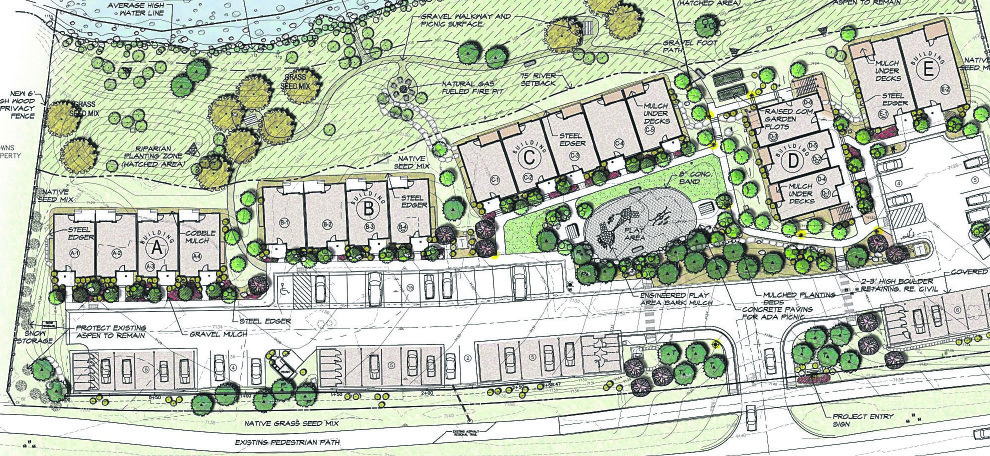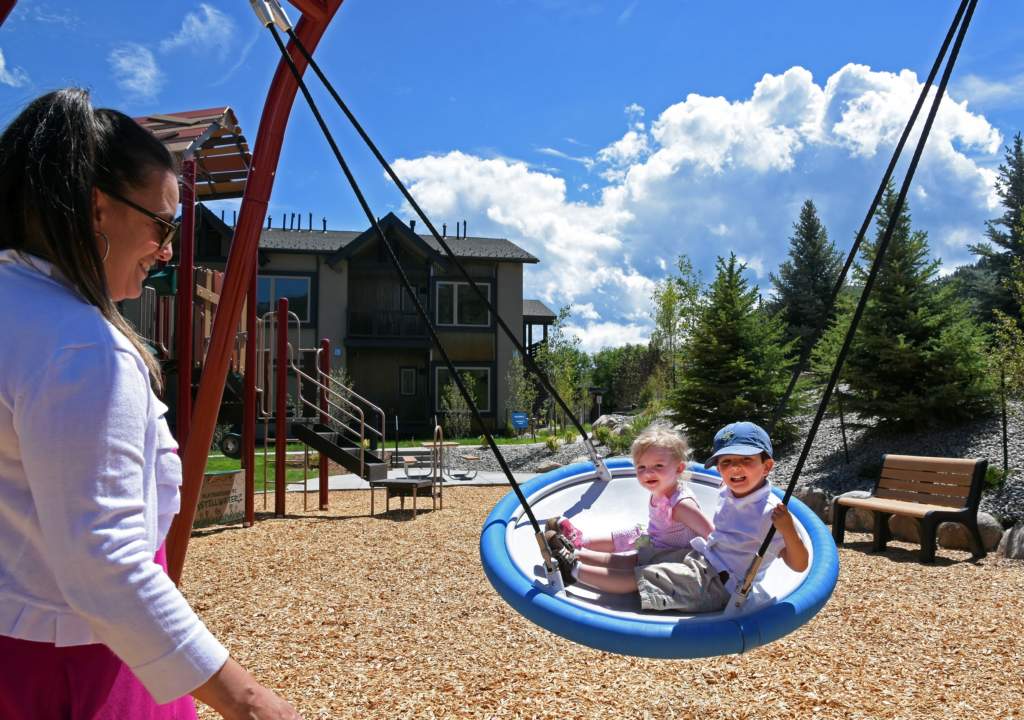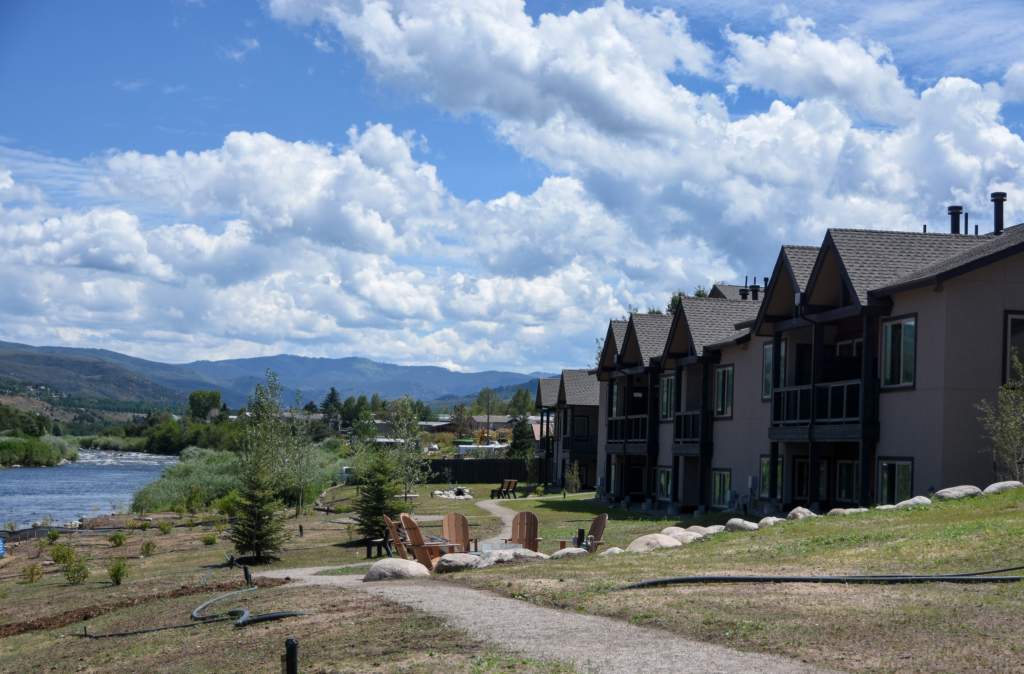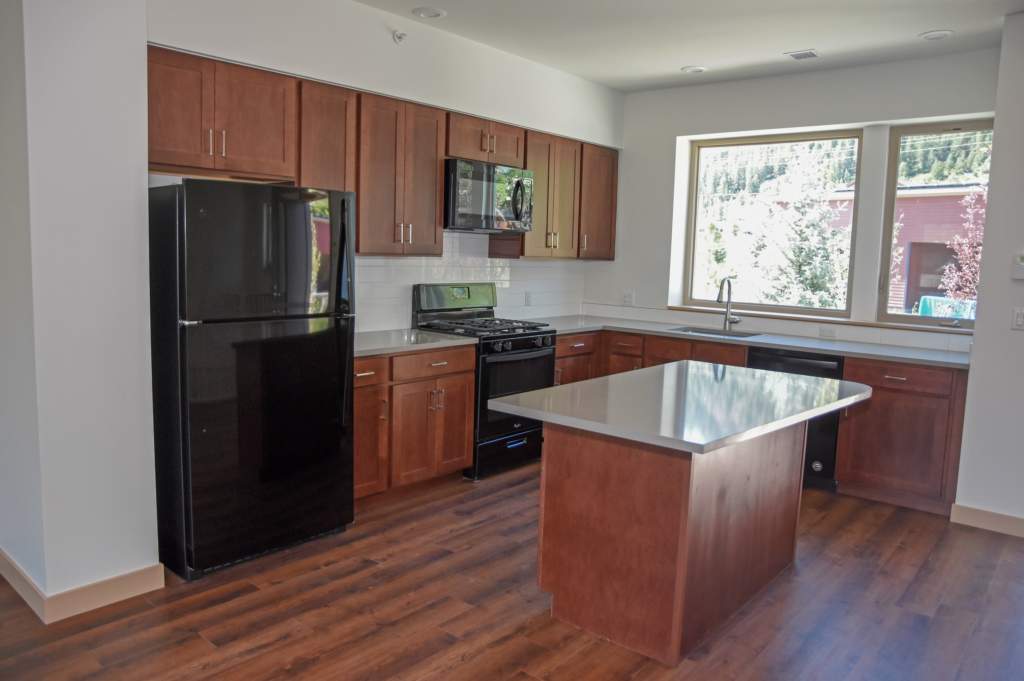
The Stillwater ribbon cutting. James Wilkins, left, Melissa Mills McLoota, Steve Coyer, Rick Pylman, Linn Brooks, Trevor MacAllister
Eagle River Water and Sanitation District opens more workforce housing
by Randy Wyrick, Vail Daily
EDWARDS — If you take care of the people who take care of you, and you should, a local water district and its employees are both in good hands. The Eagle River Water & Sanitation District opened 21 new workforce-housing units in Edwards. The ribbon cutting was Friday.
The bad-ish news is that the Stillwater project is for water district employees. The good news is that they’re hiring — nine positions right now. The even better news is that from the Stillwater condos, water district employees can stand-up paddleboard across the Eagle River to the water plant.
“We’re creating for place we are proud of, for people we are proud of,” Linn Brooks, ERWSD general manager said.
The Stillwater project is a combination of a mix of one-, two- and three-bedroom units that water district employees can rent or buy. Those 21 units bring to 56 the number of water district employee housing units. The water district can house more than half of its workforce, Brooks said.
The Stillwater project cost the water district $14 million, cash it had on hand in its reserve fund. Lease payments will cover ongoing costs, Brooks said. Dipping into that reserve fund/savings account is how they’ve funded other projects, including housing, Brooks said.
The Stillwater project will generate its own solar energy. Solar panels on top of all 21 covered garage spaces will offset the electricity used in common areas. The project will also include electric vehicle-charging stations that can handle three vehicles at once.
The water district provides water services to businesses and homes from East Vail to Cordillera.
Eagle River Water & Sanitation District’s existing workforce housing before the newly opened Stillwater housing project:
- 10 Vail units: Nine Red Sandstone 1- or 2-bedroom townhomes, one 1-bedroom Pitkin Creek condo
- 3 Avon units: Two Sunridge 2-bedroom condos, one Beaver View 3-bedroom townhome
- 10 Edwards units: Two Brett Ranch 2-bedroom condos, three Cattail 3-bedroom single family homes, five Cattail 2-bedroom townhomes 3 Eagle units: Two 3-bedroom single family homes, one 4-bedroom duplex
- 4 Gypsum units: Three Stratton Circle 3-bedroom single family homes, one Nighthawk Circle 2-bedroom townhome
A Leader in housing efforts, Eagle River Water & Sanitation District hopes Stillwater will be local model
by Pam Boyd, Vail Daily
VAIL — As employers throughout Eagle County grapple with challenges of finding workers, and more specifically finding places for workers to live, Eagle River Water & Sanitation District is an acknowledged local leader in providing workforce housing.
This leadership has been born of necessity.
“We provide these absolutely essential services to the community and they are labor intensive services,” said Eagle River Water & Sanitation District General Manager Linn Brooks.
Because failure to do its work is simply not an option, the district knows it needs people — often highly trained with very specialized skills — to carry out its mission. From there it’s a small jump to realize that those people need a place to live and that’s what brought the district into the housing arena.
Currently the district has an inventory of 39 units in its housing program. That number includes nine units that are master-leased by the organization in rental projects located around the valley. But this spring, the district will break ground on Stillwater — a 21-unit project in Edwards that included a mix of one-, two- and three-bedroom condos that district employees can rent or purchase.
CLOSE TO HOME
The Stillwater project is an ambitious effort for the district and it represents a comprehensive plan to deliver what employees desire in terms of living conditions while ensuring nimble service to customers. Lessons of the past taught the district that it is vital that employees live close to their work.
Brooks tells a familiar story. The district currently has employees who commute from as far away as Breckenridge because that’s where they can find housing. Those long commutes can spell trouble if a big water break occurs after hours and employees have a lengthy commute time before they can even respond to the problem.
Beyond the proximity issue, Brooks noted that the very nature of district jobs creates a housing need. For instance, when the district is looking for a plant operator, chances are it won’t find someone locally who has the specialized education and skills required for the job. That means someone has to move to the area and find a place to live.
Brooks noted that today’s local housing market packs a double punch — not only are housing options expensive, they are also scarce. This double trouble is one of the reasons why the district has opted to develop Stillwater.
DON’T ADD TO THE PROBLEM
By building Stillwater, the district will not only provide new housing for its own employees, it will free up the master lease units it currently holds. Therein lies a central theme of the district’s housing philosophy. Brooks noted the district’s board of directors has determined the best way to meet the organization’s workforce housing need is to provide housing specifically for employees rather than compete for available units in the open market.
“We don’t just care about our own employees, we care about the community as a whole,” said Amy Vogt, community relations assistant for the district.
With an estimated $14 million price tag, the Stillwater project represents a big investment for the district, but Brooks noted the board of directors believes it is a sound one. She pointed to a saying that one of her board members quotes in illustration. “Quality doesn’t cost, it pays.”
The district isn’t trying to turn a profit at Stillwater, Brooks noted. But the project does represent a long-term investment in the district’s future.
“The board and I take our responsibility to the community very seriously. It’s just not acceptable not to be fully staffed to meet the community need,” Brooks said.
STILLWATER

In December (2017), the district received Eagle County approval for the Stillwater plan.
“The board really wants to make this development a model for the community for how workforce housing can be done well,” Brooks said.
She noted a lot of thought has gone into the site planning. Because it is located next to the Eagle River, Brooks noted that environmental sensitivity was a paramount consideration in the Stillwater plan. Issues including storm water drainage and water use efficiency have been extensively engineered. Energy efficiency is another part of the Stillwater project, with all of the units wired to accommodate solar panel installation. Because the district’s motor fleet currently includes a pair of electric vehicles and Stillwater residents may choose to purchase their own electric cars in the future, the site includes charging stations.
Beyond these larger site-planning issues, the district also talked with employees about what they desire. As a result, Stillwater includes storage space options and a “family friendly” feel. Brooks said employees are excited about the Stillwater location, not only because it is close to work, but also because it is close to the many amenities offered in the Edwards community.
For the district, the Stillwater project also gives employees a way to stay district employees.
MOVING IN AND MOVING UP
Brooks noted that like its other housing options, employees will have the option to rent or purchase a Stillwater unit. Currently, roughly half of district housing units are rentals and the other half are owned by employees.
The district’s overall housing program includes three options for participation and employees can choose one of them. Employees can rent at a district-owned property, purchase a deed-restricted district-owned unit or receive down payment assistance to purchase a free market unit.
By providing these options, Brooks said the district hopes to give employees the tools they need to put down roots in the community. Ultimately, retaining employees is both good for district operations and finances, Brooks said.
“At the end of the day, we want our employees to choose a career with the district,” Brooks said. “We invest a lot in the training of our employees so we want them to stick around.”
Straight from the leaders themselves
by Eagle River Water & Sanitation District
Our guiding mission in designing Stillwater was: “Places to be proud of, for people we are proud of.”
With a focus on helping our employees address community-wide issues of housing affordability and availability, we’ve been refining and growing our program for years. By providing a variety of ways for employees to participate in our robust employee housing program, we’re able to attract and retain a staff of committed experts. This newest addition to our housing portfolio continues to support local housing efforts.
Stillwater adds 21 units to the district’s housing portfolio. The mission of our housing program is to enhance the district’s ability to recruit and retain a high-quality staff by providing affordable and available housing. With the opening of Stillwater we can now house up to 50% of our employees.
When we first pulled together the group for preconstruction efforts, one of the first steps we took was what we termed a “Phase Zero” approach. Our architect interviewed several of our district employees- both those already residing in district housing and those interested in doing so- to see what they most needed and wanted in housing options. That input resulted in a neighborhood that includes outdoor features such as a playground, a fire pit, grill and picnic areas, and river access, as well as spacious units with ample storage.

In designing Stillwater, our project team’s primary focus was on creating a development that is not merely housing, but is a residential community that supports our employees as they build careers at the district. We also wanted Stillwater to reflect the district’s values. In developing adjacent to the Eagle River, we wanted to enhance the riparian vegetation along the river’s edge, which protects wildlife and water quality. We wanted to reduce the impacts of stormwater to avoid erosion and enhance groundwater filtration and maintain the natural hydrology. We wanted to reduce outdoor water use and potential for landscaping contaminants to get to the river. We did that through water-efficient landscape design, including native and drought tolerant species and efficient irrigation design. And we wanted to reduce the impacts of human use by designing limited river access while still having inviting areas for outdoor activities.
“At Eagle River Water & Sanitation District, we believe that by elevating the quality of our employment- that is, providing long term career opportunities and a positive work environment- we serve not only our employees but also all of you- every one of us that has chosen this valley as our home.” –Melissa Mills McLoota, Human Resources Manager


